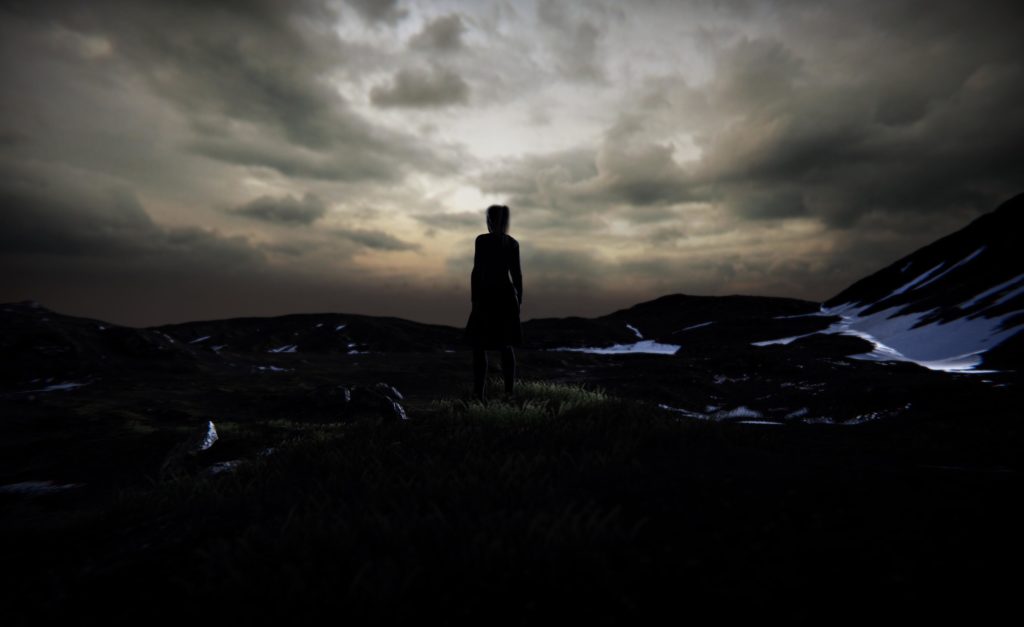Out of Time and Place
Suzanne Mooney | スザンヌ・ムーニー
6 July – 7 September, 2020
Suzanne Mooney, 2020. Out of Time and Place, mixed media.
.
|
「空き間は空間的な広がりを持つ。其処此処の間の地形を描いている。空き間は時間的な広がりを持つ。時に意識を向けている。私たちが今をとっては昔を、未来をとっては今をと、位置づけるように。歴史を綴ることは、現在における過去を配する行為で、それは未来への可能性を手向ける行為と相まうからだ。空き間は社会的な広がりを持つ。ダイアローグの場に互いに続く対話を明確に表現している。」
ジェーン・レンダール著『空き間』221ページより
.
.
スザンヌ・ムーニーは2004年以来、旅をしている。物理的、比喩的な意味での旅で。世界を渡り、彼女なりの「空き間」を探検しながら。自然景観や人と自然との関係を重んじたロマン主義の芸術家らに感化され、独り芸術的な遍歴の旅に出た彼女は、以来、時と空間の欠如した広大な景観と自身の相関関係を見つめてきた。15年に渡り、おおかた写真か映像で記録されてきた、そんな彼女の景観との交わりは、一つの物語として蓄積されるようになった。物語の舞台は所在地も時間軸も不明だが、空間との関係性に向き合ってじっくり考えることを私たちに促すともいえる。一体、私たちは場所とどのようにコミュニケーションするのだろうか?
.
この度ザ・コンテナーの『時と空間を逸して』展では、10年以上前に撮影されたものから最近のも含む映像セレクションを展示する。どの映像においても、ムーニーのシルエットはさも繊細で巧妙な介在を経て景観の一部として表現されていて、また撮影場所も世界各地と様々だ。ほとんどの景観についてはその場所が特定できないが、カメラが些細なヒントをいくつか拾っている時もある。映像の焦点はいずれにせよ、空間としての景観と、その哲学的、私的、社会的な掛り合いに絞られているのだが。
ロマン主義と同様、またはドイツ人ロマン派画家のカスパー・ダーヴィット・フリードリヒの「雲海の上の旅人」(1818年)に寄せてなのか、カメラはしばしば、景観の広大さを最大限に捉えられるような角度の位置に置かれている。ムーニーいわくそれは「場所が景観に転成する」地点であり、また、その地点は「鑑賞者の観点の限界と景観の境界線」によって定義されるという。日常生活を脱する手段として空間を探検することや彷徨することの「崇高さ」など、彼女のロマン主義への思い入れは、彼女の直感的なアプローチや作品に色濃く表現されている。彼女のシルエットがロマン派時代の絵画で一般的な男性シルエットの様相をならっているのも、彼女がジェンダーについて新たな見地や政治的位置づけを模索することと、自身の考え方を表現することを可能にさせている。 どの作品もビジュアル的、コンセプト的にも「粛然」としているのを指摘することも重要だ。ジェンダー・ポリティクス、グローバル化、社会的認識といった概念はこの上なく巧緻にほのめかされ、ささやかな連想を誘うだけである。これこそムーニーの作品の真なる魅力だ。物思いにふけったディープな瞬間を彼女は選び抜き、私たちと共有してくれている。芸術家としての彼女のアイデンティティ、彼女と、彼女が探求する景観との個人的なつながりが垣間見えてくる。おとなしくて詩的な反面、壊滅的な出来事や激的な自然現象の前触れを示唆しているようでもある。ロマン主義絵画の多くの作品と同様、むら気で、感情の起伏とインパクトが高いだけに、崇高だ。 他の作品で問いかけたことへの回答も、これらの作品中に探しやすい。都市景観を探検した写真シリーズの「街中を歩いて」、池袋のサンシャイン・シティで撮られた東京の鳥瞰図、女性の身体を模索して写した古い写真など。15年間の営みを導いてきたきっかけに新たな見識を得る許可を彼女がくれているかのようだ。作品中、背面でゆっくりと静かに熟しているかのような存在だが、実際には彼女が芸術と自我について、核として理解していることを代表している。 究極の物語行為、「ストーリー・テリング」を捉える本シリーズは、鑑賞者自身が映像内のシルエットと化し、まるでアバターのように、どこか特定の視点から空間を静かに見つめることをじわじわと誘ってくる。ムーニーの他の作品の多くのように、彼女のテクノロジーへの深い関心が意識される。とりわけ、原映像と編集映像の交錯によって織りなされるサスペンスは、現実とバーチャルとの明確な区別がないことから、恐怖感も湧いてくる。「私の作品では、自然のリズミカルで循環的なパターンに、モーフィング技術、ビデオの折り重ね、シームレスなループ再生など新たなテクノロジーの特徴が並列している」と、ムーニーはいう。 本展『時と空間を逸して』では、ムーニーが長い年月をかけて制作した4本の映像(最も古いのは2004年作)と今回のために作った1本の映像(2020年作)を展示している。展示物は彼女が16年に渡り、芸術家と一個人して進化してきたことを物語っている。なお、初期のものも含め、ほとんどの映像は日本で展示されたことがない。ザ・コンテナーはそんな作品を横並びに鑑賞できる貴重な機会を設けられたのである。 |
A place between is spatial, it is a mapping of the topographies between here, there and elsewhere. A place between is temporal, it pays attention to time, to the ways in which we locate the then from the now, the now from the yet-to-come, for in our writings of history, our placing of the past in the present, we are already positioning possibilities for the future. A place between is social, it is an articulation of the place of dialogue, ongoing discussion, between one and another. Jane Rendell, A Place Between, p.221
AAASince 2004, Suzanne Mooney has been on a journey, physically and metaphorically, traveling the world and exploring her own “between places”. Inspired by the Romantics—their preoccupation with landscapes and their relationship to nature—Mooney has embarked on a personal and artistic peregrination, examining her personal interrelation with vast landscapes, devoid of time and place. These interactions of Mooney’s with landscapes over the last 15 years, usually documented in photography and video, have accumulated into a narrative—timeless and set in an unidentifiable location—that encourages contemplation and reflection about our relationship to spaces; how do we communicate with a place? AAAThe exhibition at The Container, Out of Time and Place, showcases a selection of videos, some taken over a decade ago and some recently, all displaying Mooney’s silhouette as part of landscape, through delicate and subtle interventions in a variety of locations around the globe. Mostly, the landscapes are not recognizable as specific locations, but sometimes there are a few little hints that the camera picks up; regardless, the focus is always on the landscape itself as a space, with philosophical, personal, and and social implications. AAAIn a similar fashion to Romanticism, perhaps in an ode to the German Romantic artist Caspar David Friedrich’s Wanderer above the Mist (1818), often the camera is positioned to examine the landscape from a perspective that exerts the vastness of the locations, where the “land is transformed into landscape”, Mooney asserts, and defined by “the limitations of the viewpoint of that viewer, the borders of the view.” Mooney’s pensiveness in Romantic ideas such as the sublime—exploring or “getting lost” in spaces as a means to escape everyday life—are strongly evident in the works, such as her intuitive approach. Her silhouette, which echoes the common Romantic silhouettes of men from paintings from that era, enables Mooney also to communicate ideas about gender, exploring new territories and politics. AAAIt is important to say, that the works are all “very quiet”, visually and conceptually, and even ideas such as gender politics, globalization or social awareness are implied in the most delicate fashion, merely a subtle suggestion. This is the real strength of these works, which present highly personal moments of reflection Mooney selected to share with us. They are pieces that allow glimpses into the artist’s own identity and her own connection to the landscapes she explores. They are tame and poetic, but somehow also able to suggest apocalyptic consequences or foretell of looming extreme natural events. Like many Romantic works, they are moody and high in emotion and impact, but also sublime. AAAIt is easy to find in this body of works answers for many of Mooney’s other works, from her “Walking in the City” series of photographs where she explores urban landscapes, to her birds-eye view images of Tokyo, taken from Sunshine City in Ikebukuro, or even her older photographs exploring the female body. It is almost as though Mooney is authorizing the viewers to gain insight into the catalyst that informs her entire practice over the last 15 years—slowly and quietly brewing in the background, but in fact, represents Mooney’s core understanding of art and self. AAAThis series captures storytelling at its best, slowly inviting the viewers to position themselves as the silhouette, like an avatar, to serenely inspect the space from that specific viewpoint. As in many of Mooney’s works, there is a deep interest in technology and the suspense she builds with the use of authentic footage and manipulated footage, makes the viewers apprehensive; there is no clear distinction between the real and the virtual. “In my works,” she says, “the rhythm and cyclical patterns of nature are juxtaposed against the qualities of new technologies, including morphing techniques, layering of video and seamless loops.” AAAOut of Time and Place, includes four historical video works of Mooney (the earliest from 2004) and a new video that was created for this exhibition (2020), to narrate the evolution of Mooney as an artist and as an individual over the last 16 years. Most of the videos, even the early ones, have never been exhibited in Japan, and the installation at The Container brings an engaging opportunity to view these works side-by-side for the very first time. |
